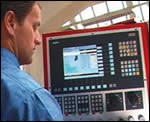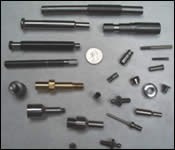Shop Jumps Into CNC Machining
Although this shop was already established and highly successful, it recently decided to make the "jump" into CNC machines, acquiring three new machines.
Orscheln, LLC (Moberly, Missouri) had always subscribed to the time-tested and reliable old maxim, “If it ain’t broke, don’t fix it.”
Founded in 1938, this 47,000-square-foot screw machining facility, with 54 employees and a range of services, produces products for automotive, marine, aircraft, military/defense, recreational and housing market customers. It specializes in turning, forming, laser cutting, crimping, welding, bending and coating to manufacture such end products as marine cables, aircraft control cables, electronic throttle controls, engine/valve/pump controls, fluid level indicators, parking brake cables and levers, push-pull cables, trailer parking brake systems and transmission shift controls.
Typically, this Orscheln facility fabricates products from various grades of carbon steel, stainless steel, brass and aluminum. The majority of its conventional screw machining was done on the benchmark brands of equipment: Wickman, Acme, Davenport and Brown & Sharpe. When necessary, the company outsourced some work because of workload or part particulars.
Although this shop was already established and highly successful, it recently decided to make the “jump” into CNC machines, acquiring three EmcoTurn 420 machines and one EmcoTurn 332 from Emco Maier USA (Columbus, Ohio). As Daryl Duschene, plant superintendent for this facility, explains, “We bought our first CNC machines, and there was some hesitation until we began to use them. As first-time users of CNC, we anticipated a long learning curve, and we were concerned about its impact on our productivity. However, we quickly found that our learning curve was minimal because of the operator-friendly Siemens Sinumerik 840D controls onboard all the machines.”
On its CNCs, Orscheln uses the controls for axis and spindle positioning, most often storing the parts programs directly in the memory of the machine’s CNC control. The facility transfers other programs to and from their resident network via a hand-held PC.
Mr. Duschene further commented, “In setting the threading data on one of the CNC machines, we especially like the very precise 0.0001 inch incremental movement of the axes and the user-friendly graphics. Our operators and QC personnel have commented several times how the dimensions of our finished components stay within tolerance with very little variation. This gives us great confidence in the machines, the controls and the overall process. So much confidence, in fact, that we’ve actually run the machines untended for several hours with excellent results. For first-time CNC users, we experienced very short learning curves, and we mostly taught ourselves. We went from the installation date of the first two EmcoTurn 420s to fully-loaded production runs on three shifts within only 3 months. When you add in the fact that we ran more than 130 different part numbers in that time, it’s remarkable how easy it was to get the job done.”
Plans are in the works for Orscheln to acquire additional CNC machines, all projected to include Siemens 840D controls and drive packages. The company reports improvements in both part cost and quality, resulting from using the CNC machines. Mr. Duschene explains, “Part quality was greatly improved in several ways. Surface finish has notably improved. We now have the capability to hold tolerances of ±0.001 inch, whereas before we couldn’t. Our process capability now allows us to achieve a 1.67 Cpk for our customers. We have eliminated secondary operations, thereby reducing our leadtime for our customers.”
On the dual-spindle machines, one part program runs on the CNC, simultaneously producing both parts without interruption or collision, the result of Siemens Simodrive 611U drives, part of the Sinumerik 840D powerline package, according to Emco Maier.
As a result of its quick ramping up on CNC operations, plus the demonstrated improvements in part quality and the overall time to produce, Orscheln has been able to perform more work in-house. At this successful shop, “good got better,” and the company credits the enhancements CNC has brought for much of that growth.
Related Content
How to Start a Swiss Machining Department From Scratch
When Shamrock Precision needed to cut production time of its bread-and-butter parts in half, it turned to a new type of machine tool and a new CAD/CAM system. Here’s how the company succeeded despite the newness of it all.
Read MoreHack-Proof Your Shop: Production Machining’s 6 Must-Read Cybersecurity Articles
October is cybersecurity awareness month and Production Machining wants to help you make your shop hack-proof.
Read MoreThe Value of CAD/CAM and Cutting Tool Manufacturers Working Together
Overall machining efficiency can be increased when software and tooling companies combine to tackle machining challenges.
Read MoreStandard Control Functions with Swiss-Types in Mind
Features in this line of machine-specific CNCs assist setups, offer synchronized movement commands and provide other standard, not optional, capabilities to streamline Swiss-type programming.
Read MoreRead Next
Emerging Leaders Nominations Now Open
Here’s your chance to highlight a young person in your manufacturing business who is on the path to be a future leader moving your company forward.
Read MoreA Tooling Workshop Worth a Visit
Marubeni Citizen-Cincom’s tooling and accessory workshop offers a chance to learn more about ancillary devices that can boost machining efficiency and capability.
Read MoreDo You Have Single Points of Failure?
Plans need to be in place before a catastrophic event occurs.
Read More










.jpg;maxWidth=300;quality=90)













